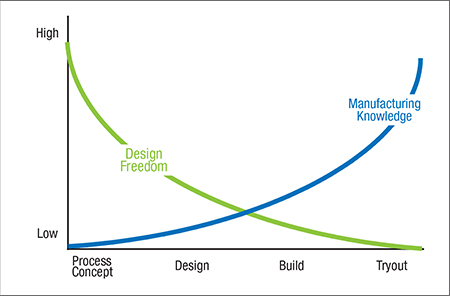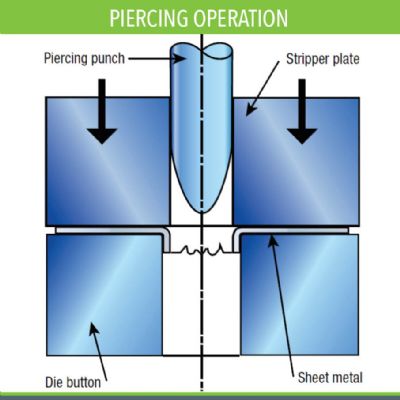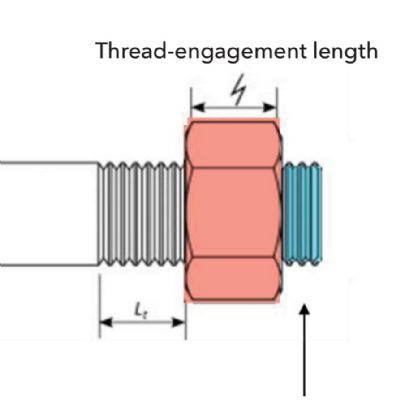Progressive-Die Strip Analysis—Part 2
June 1, 2016Comments
With progressive dies, the distance between workstations is of prime concern for the die designer, die builder and press technicians. Part quality depends upon this distance—called stock pitch or die progression—remaining constant throughout the stamping process.
Each time the press cycles, an automatic feeding system pushes or pulls a strip of material from a coil through the stations of the die. The strip feeds a predetermined distance and, through the use of pilots or locators in subsequent stations, is precisely located. When shops fail to properly control strip progression, the die strip may exhibit distorted pilot holes, misaligned match-cuts or any number of other defects.
Die-Strip Flexing
 When draw-forming a part in a progressive die, the blank edge must be free to flow inward toward the die cavity. Accomplish this through the use of stretch-webs and stretch-carriers.
When draw-forming a part in a progressive die, the blank edge must be free to flow inward toward the die cavity. Accomplish this through the use of stretch-webs and stretch-carriers.
Some draw-forming processes produce parts having different heights. The free flow of material and the resulting product geometry can combine to alter the relationship between the station-to-station centerline of the die and the part-to-part centerline in the strip. This causes the die strip to move sideways, flex vertically, or both. Here, the stamper should provide a flexible loop in the carrier, to permit flexing and movement of the blank without pulling the adjacent parts out of position (Fig. 1).
 Also pay at-tention, during draw-forming, to the vertical movement of parts in the die stations as the die opens and closes during the press stroke. For example, vertical movement can occur between draw stations when more than one draw is required to complete the part (Fig. 2). Die operations that cause the carrier web to move or flex require properly designed stretch carrier(s) to prevent such problems.
Also pay at-tention, during draw-forming, to the vertical movement of parts in the die stations as the die opens and closes during the press stroke. For example, vertical movement can occur between draw stations when more than one draw is required to complete the part (Fig. 2). Die operations that cause the carrier web to move or flex require properly designed stretch carrier(s) to prevent such problems.
Check the die strip for steps, burrs or nicks in the edges of the carrier strip. These inconspicuous defects can become sites for stress risers, which eventually may lead to distorted or broken part carriers. Eliminate their causes.
Also, be sure to inspect the die strip closely for signs of vertical movement whenever a flange is formed upward in a progressive-die station that sits adjacent to stations using upper pressure pads. These pads are used to hold down the connecting parts.
Wrinkles Tell a Story
Draw-forming operations require holding forces applied over the flange area of a flat blank flange in order to control material flow into the die cavity. This force must be sufficiently low to produce the required part shape with minimal stretching, yet high enough to prevent wrinkle formation.
When wrinkles do occur, their locations on the part can help differentiate between stretching and drawing modes. Wrinkles on or around the punch nose, sometimes called “puckers,” indicate that restraining forces may be too low during initial punch contact. Holding pressure may need to increase to as much as 10 times the punch force, depending on material type and thickness. To promote stretching over the punch face, stampers can consider increasing the blank size, reducing lubrication between the sheet and the pressure pad, roughening the pad, or adding lock beads.
Wrinkles in the flange area or near the die radius indicate the presence of in-plane compressive forces that are synonymous with deep drawing. The required blankholder pressure may be as high as 40 percent of the punch force, depending upon material type and thickness. Other options: Reduce the size of the die entry radius, add draw beads or reduce punch-to-die clearance.
Problems Due to Unbalanced Loads
Forming sequences in a progressive die occur much higher in the press stroke than they do during punching and cutting. When the working forces in a progressive die are not distributed evenly, the press slide (ram) can tip and move laterally in the direction of the greatest force. If this movement occurs with the punches engaged with other die components, excessive wear or damage can occur.
Unbalanced loads may be detectable during the die-strip analysis. Look for punched holes and opposing trim edges where the cutting clearance appears to be too tight on one side of the cut and too loose on the other side. If cutting clearance appears on-center when the die is out of the press and inspected in the toolroom, chances are good that the die is tipping due to unbalanced loading.
To help ensure part quality, work to maintain an even distribution of the work load across the press slide. This practice also will improve die life and reduce press maintenance. Evaluate the progressive-die strip and the timing of the die stations to better manage die-tipping moments caused by unbalanced loads. MF
View Glossary of Metalforming Terms
Technologies: Tooling









